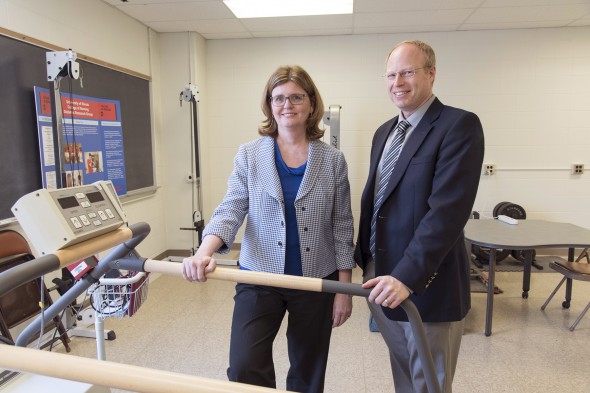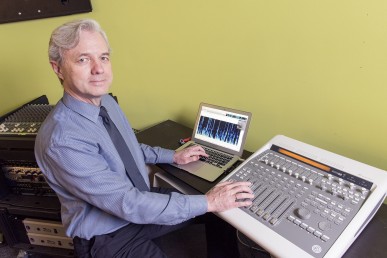East Meets West: Music as a motivator to move through the pain

College of Nursing faculty Eileen Collins and Ulf Bronas study peripheral artery disease, which makes movement painful. Photo: Roberta Dupuis-Devlin
East Meets West is a collaboration of Provost Susan Poser and Vice Chancellor of Health Affairs Robert Barish
Music motivates people to get up and move, but does it have the power to encourage people to move even when moving is painful?
UIC researchers from the east and west sides of campus are collaborating on a pilot study to see if music can help patients with peripheral artery disease — which makes movement painful — stick with an exercise regimen.
“We’re trying to find a way to use music to promote exercise and distract from the pain,” said Eileen Collins, professor of the biobehavioral health science in the College of Nursing.
Collins is collaborating on the project with Ulf Bronas, associate professor in the biobehavioral health science department, and Steve Everett, dean of the College of Architecture, Design, and the Arts.
Everett, a noted composer, will manipulate the music so that it encourages patients to get moving.
“He’s able to take the artistic part of music and play with it a little and turn it into science to make the brain and the muscles work together in ways that we don’t think about,” Collins said.

Steve Everett, dean of the College of Architecture, Design, and the Arts. Photo: Roberta Dupuis-Devlin
Participants in the pilot study will be patients from the University of Illinois Hospital and the Edward Hines, Jr. VA Hospital who suffer from peripheral artery disease, a condition that causes claudication — a cramping, painful feeling in the legs.
“These patients are limited to walking half a block to a block before they experience significant leg pain,” Bronas said. “They have to stop and rest three to five minutes, then the pain goes away and they can walk again.”
Age, diabetes and smoking are the major risk factors for the disease, which is improved most effectively through walking. Supervised exercise programs help relieve pain, Collins said, but these programs often are not reimbursed by insurance.
“Patients essentially are told to go home and walk, and they don’t do it because it’s painful,” Collins said.
Researchers aim to create a home-based exercise regimen that participants can stick with on their own.
“We are encouraging walking at home to see if the music makes a difference in how far people walk without pain,” Collins said.
“We want to really empower individuals to take charge of their own health care,” Bronas added.
Everett will create playlists based on musical genres that the participants enjoy and manipulate songs to encourage them to walk.
“We can use music as a way to lessen the pain in certain patients,” Everett said.
The researchers plan to complete the pilot study this summer and submit grant proposals in the fall for a larger study.
Their collaboration was formed by chance when Collins met Everett at a committee meeting. Collins was filling in for a colleague who couldn’t attend the meeting and started talking to Everett about his work, then later realized his expertise could be helpful as she and Bronas discussed research ideas.
“His experience in music as motivation was perfect,” Bronas said. “Meeting new people throughout campus is really important.”
Music also has medical applications beyond peripheral artery disease, Everett said, such as helping patients with Alzheimer’s recall songs they enjoyed in their childhood.
“There are so many areas where people are trying to understand how music has this ability to work with certain medical conditions,” he said. “There are underlying tones that music is not just something for pleasure; it’s something that’s maybe much more critical for our own psychological health.”
The opportunities for students studying music and sound design are expanding far beyond the traditional prospects of composing concert music and designing sound for theater, Everett said. His students are finding jobs using their musical skills in fields such as computational informatics and sonification, which involves using audio to express data.
“Students are finding work in industries now that really 20 years ago weren’t there,” he said.
Collaborations across disciplines are critical for solving problems, Everett said.
“Ideas are no longer formed in silos,” he said. “Great universities have a way to build conversations across silos.”
